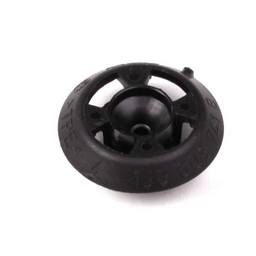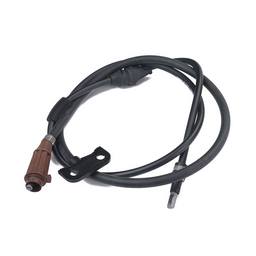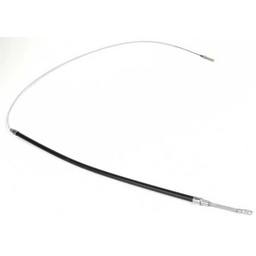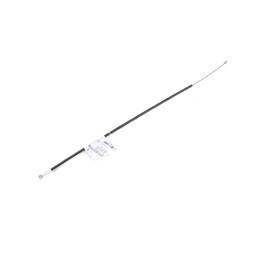Mechanical emergency parking brakes are slowly becoming a thing of the past. More and more modern cars are coming out with electronic e-brakes that are entirely removing the mechanical link between the cockpit and the parking brake itself. However, if you drive an older car like the SAAB 9000 that we’re going to talk more about today, you still get to enjoy the emergency brake cable’s wonder. That being said, you also get to experience all the problems this design brings!
Emergency Brake Cable – What Does it Do?
Back in the ‘olden days’ before electronics replaced every single system in a car, you had manual emergency brakes. The idea was and still is to have a mechanical link between you and the rear brakes using a set of cables and usually a lever (mostly on manual cars).
You would apply pressure to the rear brakes by pulling the lever, thus creating a braking force. However, most modern cars got rid of this feature, replacing the whole thing with an electronic emergency brake. Is this a better option? It depends.
Most car enthusiasts appreciate a mechanical fail-safe for several reasons. For one, you can rely on the mechanical emergency brake in case you lose hydraulics mid-drive. There’s also the notion that mechanical emergency brakes are simpler than their modern counterparts and simpler means more robust. Lastly, it’s cool to do handbrake 180s from time to time if you know-how.
However, none of the above changes the fact that emergency or parking brake cables tend to fail over time.
How Does an Emergency Brake Cable Fail?
Emergency brake cables fail for all kinds of reasons. Often times, it has to do with the effects of the environment the car is in. If you look at parking brake cables, you’ll notice that they’re sitting in a protective sleeve. Once this sleeve goes bad over time due to exposure, the cable inside begins to corrode and no longer offers the functionality it once had.
The symptoms of a bad cable can swing two ways:
- Emergency Brake Doesn’t Work – One of the most common symptoms of a bad cable is an emergency brake that doesn’t hold. You’ll find yourself pulling the handbrake as hard as you can, yet your car would still move. If it happens that you need to park on a steep hill or uneven terrain, you might need to rely on your gearbox to hold the car in place if you drive a manual.
- Emergency Brake Stuck – The other way a bad cable can swing is to lock the rear brakes. This is often solved by simply applying mechanical force on the emergency brake pivot lever on each wheel. Then again, that may not be enough either.
The good thing is that a stuck emergency brake, or one that won’t hold, doesn’t necessarily mean that your cables are toast. It could mean that you simply need to adjust them. This is done by removing the handbrake boot and tightening up the cables using a set of screwdrivers or appropriate wrenches depending on the car.
Replacing the Emergency Brake Cables
Replacing the emergency brake cable isn’t all too complicated. You’ll need a few tools such as a size 13 wrench, pliers, an Allen key, some Torx bits, and more depending on your car’s make and model. You’ll also need jack stands and floor jacks since the vehicle has to be elevated in the rear. There are cable replacement kits out there that have everything you need for your car, so make sure to check if there’s such a kit for your car.
We’ll demonstrate the process on a SAAB 9000 – our guinea pig for this project. However, keep in mind that steps are similar in most cars with mechanical emergency brakes that use cables. That being said, let’s jump right in.
Step 1 – Jack the Car Up
Put the car into gear and make sure that the emergency brake is released. Now jack the car up and place your jack stands in the rear. Make sure that the vehicle is stable before proceeding to remove both rear wheels. Once that is done, reach behind and check to see if the emergency brake pivot levers are stuck. In case they’re stuck, your issue might be with the rear calipers and not the cable.
Step 2 – Tune the Caliper
Our next step is to remove a size 13 bolt found right underneath the cable boot in behind the caliper. Once you remove the bolt, you’ll find an Allen screw. Tighten the screw so that the rotors no longer spin. Then, start undoing the screw and stop when the rotors begin to spin freely again. Congrats, you’ve tuned your rear calipers!
Step 3 – Tighten the Cables
Tightening the cables is usually a simple procedure, but it requires removing the center console on the SAAB 9000. To do so, you’ll need a size 25 Torx bit and a 10mm socket wrench. Once the console is out of the car, you’ll see the cable ends with barrel adjusters on them.
Tighten them as much as you can and try your hand brake. If it’s working, your cable only needed adjustment. However, if the rotors are still spinning, it’s time for a replacement.
Step 4 – Unhook the Cable Housing
Remove the white emergency brake cable housing retainer clips found underneath the carpet where the center console used to be. By doing so, you’ll allow the whole housing to pass through the floor of the car.
Step 5 – Understand the Layout of Both Cables
Once the cable is free on the inside, get underneath the car and start mapping how the cables are routed. The passenger-side one is not the issue, but the driver-side cable is routed seemingly through everything.
Step 6 – Remove the Passenger-Side Cable
Unhook the cable from the caliper and disconnect the trailing arm. Now pull the housing through the floor of the car and remove the entire cable. Install the replacement in reverse order.

Step 7 – Remove and Replace the Driver-Side Cable
Next, remove and replace the driver-side cable. The easy way to do this is first to route the new cable while removing the old one. All you have to do is use some duct tape and tape the new cable’s interior end to the old cable.
Once taped, start pulling the cable from inside the car until the new cable sits in place. Remove the old cable, hook up the new one, and you’re set.
Step 8 – Check that Both Cables are Connected to Caliper Levers
At this point, double-check that the brake cable is connected to the calipers and check the routing. If everything is alright, tighten down the new cables using those barrel adjusters and put everything back together. Once you’re ready, take the car out for a test drive and apply adjustments as necessary.
How to Find the Right Emergency Brake Cable?
If you own a European car, the chances are that we have what you need. We carry a wide range of OEM, Genuine, and aftermarket parking brake cables and various accessories. All you need to do is head over to our online store, type in your car’s specs, and you’ll get a list of matching parts.
If you’re unsure whether the parts on the list fit your vehicle or have any other questions regarding our products, feel free to get in touch with us. You can reach us via email or by phone. Our customer service reps are standing by to help.








